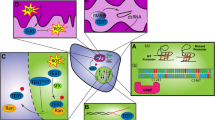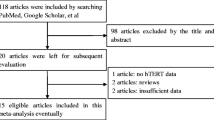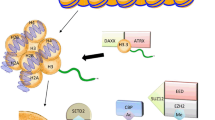Abstract
Children with high-grade glioma, including diffuse intrinsic pontine glioma (DIPG), have a poor prognosis despite multimodal therapy. Identifying novel therapeutic targets is critical to improve their outcome. We evaluated prognostic roles of telomere maintenance mechanisms in children with HGG, including DIPG. A multi-institutional retrospective study was conducted involving 50 flash-frozen HGG (35 non-brainstem; 15 DIPG) tumors from 45 children (30 non-brainstem; 15 DIPG). Telomerase activity, expression of hTERT mRNA (encoding telomerase catalytic component) and TERC (telomerase RNA template) and alternative lengthening of telomeres (ALT) mechanism were assayed. Cox Proportional Hazard regression analyses assessed association of clinical and pathological variables, TERC and hTERT levels, telomerase activity, and ALT use with progression-free or overall survival (OS). High TERC and hTERT expression was detected in 13/28 non-brainstem HGG samples as compared to non-neoplastic controls. High TERC and hTERT expression was identified in 13/15 and 11/15 DIPG samples, respectively, compared to controls. Evidence of ALT was noted in 3/11 DIPG and 10/19 non-brainstem HGG specimens. ALT and telomerase use were identified in 4/19 non-brainstem HGG and 2/11 DIPG specimens. In multivariable analyses, increased TERC and hTERT levels were associated with worse OS in patients with non-brainstem HGG, after controlling for tumor grade or resection extent. Children with HGG and DIPG, have increased hTERT and TERC expression. In children with non-brainstem HGG, increased TERC and hTERT expression levels are associated with a worse OS, making telomerase a promising potential therapeutic target in pediatric HGG.

Similar content being viewed by others
References
Blackburn EH (1991) Structure and function of telomeres. Nature 350(6319):569–573. doi:10.1038/350569a0
Feng J, Funk WD, Wang SS, Weinrich SL, Avilion AA, Chiu CP, Adams RR, Chang E, Allsopp RC, Yu J et al (1995) The RNA component of human telomerase. Science 269(5228):1236–1241
Weinrich SL, Pruzan R, Ma L, Ouellette M, Tesmer VM, Holt SE, Bodnar AG, Lichtsteiner S, Kim NW, Trager JB, Taylor RD, Carlos R, Andrews WH, Wright WE, Shay JW, Harley CB, Morin GB (1997) Reconstitution of human telomerase with the template RNA component hTR and the catalytic protein subunit hTRT. Nat Genet 17(4):498–502. doi:10.1038/ng1297-498
Counter CM, Avilion AA, LeFeuvre CE, Stewart NG, Greider CW, Harley CB, Bacchetti S (1992) Telomere shortening associated with chromosome instability is arrested in immortal cells which express telomerase activity. EMBO J 11(5):1921–1929
Kim NW, Piatyszek MA, Prowse KR, Harley CB, West MD, Ho PL, Coviello GM, Wright WE, Weinrich SL, Shay JW (1994) Specific association of human telomerase activity with immortal cells and cancer. Science 266(5193):2011–2015
Broccoli D, Young JW, de Lange T (1995) Telomerase activity in normal and malignant hematopoietic cells. Proc Natl Acad Sci USA 92(20):9082–9086
Shay JW, Bacchetti S (1997) A survey of telomerase activity in human cancer. Eur J Cancer 33(5):787–791. doi:10.1016/S0959-8049(97)00062-2
Takakura M, Kyo S, Kanaya T, Tanaka M, Inoue M (1998) Expression of human telomerase subunits and correlation with telomerase activity in cervical cancer. Cancer Res 58(7):1558–1561
Wu A, Ichihashi M, Ueda M (1999) Correlation of the expression of human telomerase subunits with telomerase activity in normal skin and skin tumors. Cancer 86(10):2038–2044
Poole JC, Andrews LG, Tollefsbol TO (2001) Activity, function, and gene regulation of the catalytic subunit of telomerase (hTERT). Gene 269(1–2):1–12
Avilion AA, Piatyszek MA, Gupta J, Shay JW, Bacchetti S, Greider CW (1996) Human telomerase RNA and telomerase activity in immortal cell lines and tumor tissues. Cancer Res 56(3):645–650
Blasco MA, Rizen M, Greider CW, Hanahan D (1996) Differential regulation of telomerase activity and telomerase RNA during multi-stage tumorigenesis. Nat Genet 12(2):200–204. doi:10.1038/ng0296-200
Langford LA, Piatyszek MA, Xu R, Schold SC Jr, Shay JW (1995) Telomerase activity in human brain tumours. Lancet 346(8985):1267–1268
Chong EY, Lam PY, Poon WS, Ng HK (1998) Telomerase expression in gliomas including the nonastrocytic tumors. Hum Pathol 29(6):599–603
Le S, Zhu JJ, Anthony DC, Greider CW, Black PM (1998) Telomerase activity in human gliomas. Neurosurgery 42(5):1120–1124 (discussion 1124–1125
Huang F, Kanno H, Yamamoto I, Lin Y, Kubota Y (1999) Correlation of clinical features and telomerase activity in human gliomas. J Neurooncol 43(2):137–142
Boldrini L, Pistolesi S, Gisfredi S, Ursino S, Ali G, Pieracci N, Basolo F, Parenti G, Fontanini G (2006) Telomerase activity and hTERT mRNA expression in glial tumors. Int J Oncol 28(6):1555–1560
Bryan TM, Marusic L, Bacchetti S, Namba M, Reddel RR (1997) The telomere lengthening mechanism in telomerase-negative immortal human cells does not involve the telomerase RNA subunit. Hum Mol Genet 6(6):921–926
Henson JD, Neumann AA, Yeager TR, Reddel RR (2002) Alternative lengthening of telomeres in mammalian cells. Oncogene 21(4):598–610. doi:10.1038/sj.onc.1205058
Heaphy CM, Subhawong AP, Hong SM, Goggins MG, Montgomery EA, Gabrielson E, Netto GJ, Epstein JI, Lotan TL, Westra WH, Shih Ie M, Iacobuzio-Donahue CA, Maitra A, Li QK, Eberhart CG, Taube JM, Rakheja D, Kurman RJ, Wu TC, Roden RB, Argani P, De Marzo AM, Terracciano L, Torbenson M, Meeker AK (2011) Prevalence of the alternative lengthening of telomeres telomere maintenance mechanism in human cancer subtypes. Am J Pathol 179(4):1608–1615. doi:10.1016/j.ajpath.2011.06.018
McDonald KL, McDonnell J, Muntoni A, Henson JD, Hegi ME, von Deimling A, Wheeler HR, Cook RJ, Biggs MT, Little NS, Robinson BG, Reddel RR, Royds JA (2010) Presence of alternative lengthening of telomeres mechanism in patients with glioblastoma identifies a less aggressive tumor type with longer survival. J Neuropathol Exp Neurol 69(7):729–736. doi:10.1097/NEN.0b013e3181e576cf
Hakin-Smith V, Jellinek DA, Levy D, Carroll T, Teo M, Timperley WR, McKay MJ, Reddel RR, Royds JA (2003) Alternative lengthening of telomeres and survival in patients with glioblastoma multiforme. Lancet 361(9360):836–838
Goldberg AD, Banaszynski LA, Noh KM, Lewis PW, Elsaesser SJ, Stadler S, Dewell S, Law M, Guo X, Li X, Wen D, Chapgier A, DeKelver RC, Miller JC, Lee YL, Boydston EA, Holmes MC, Gregory PD, Greally JM, Rafii S, Yang C, Scambler PJ, Garrick D, Gibbons RJ, Higgs DR, Cristea IM, Urnov FD, Zheng D, Allis CD (2010) Distinct factors control histone variant H3.3 localization at specific genomic regions. Cell 140(5):678–691. doi:10.1016/j.cell.2010.01.003
Drane P, Ouararhni K, Depaux A, Shuaib M, Hamiche A (2010) The death-associated protein DAXX is a novel histone chaperone involved in the replication-independent deposition of H3.3. Genes Dev 24(12):1253–1265. doi:10.1101/gad.566910
Lewis PW, Elsaesser SJ, Noh KM, Stadler SC, Allis CD (2010) Daxx is an H3.3-specific histone chaperone and cooperates with ATRX in replication-independent chromatin assembly at telomeres. Proc Natl Acad Sci USA 107(32):14075–14080. doi:10.1073/pnas.1008850107
Schwartzentruber J, Korshunov A, Liu XY, Jones DT, Pfaff E, Jacob K, Sturm D, Fontebasso AM, Quang DA, Tonjes M, Hovestadt V, Albrecht S, Kool M, Nantel A, Konermann C, Lindroth A, Jager N, Rausch T, Ryzhova M, Korbel JO, Hielscher T, Hauser P, Garami M, Klekner A, Bognar L, Ebinger M, Schuhmann MU, Scheurlen W, Pekrun A, Fruhwald MC, Roggendorf W, Kramm C, Durken M, Atkinson J, Lepage P, Montpetit A, Zakrzewska M, Zakrzewski K, Liberski PP, Dong Z, Siegel P, Kulozik AE, Zapatka M, Guha A, Malkin D, Felsberg J, Reifenberger G, von Deimling A, Ichimura K, Collins VP, Witt H, Milde T, Witt O, Zhang C, Castelo-Branco P, Lichter P, Faury D, Tabori U, Plass C, Majewski J, Pfister SM, Jabado N (2012) Driver mutations in histone H3.3 and chromatin remodelling genes in paediatric glioblastoma. Nature 482(7384):226–231. doi:10.1038/nature10833
Wu G, Broniscer A, McEachron TA, Lu C, Paugh BS, Becksfort J, Qu C, Ding L, Huether R, Parker M, Zhang J, Gajjar A, Dyer MA, Mullighan CG, Gilbertson RJ, Mardis ER, Wilson RK, Downing JR, Ellison DW, Baker SJ (2012) Somatic histone H3 alterations in pediatric diffuse intrinsic pontine gliomas and non-brainstem glioblastomas. Nat Genet 44(3):251–253. doi:10.1038/ng.1102
Khuong-Quang DA, Buczkowicz P, Rakopoulos P, Liu XY, Fontebasso AM, Bouffet E, Bartels U, Albrecht S, Schwartzentruber J, Letourneau L, Bourgey M, Bourque G, Montpetit A, Bourret G, Lepage P, Fleming A, Lichter P, Kool M, von Deimling A, Sturm D, Korshunov A, Faury D, Jones DT, Majewski J, Pfister SM, Jabado N, Hawkins C (2012) K27 M mutation in histone H3.3 defines clinically and biologically distinct subgroups of pediatric diffuse intrinsic pontine gliomas. Acta Neuropathol 124(3):439–447. doi:10.1007/s00401-012-0998-0
Takakura M, Kyo S, Kanaya T, Hirano H, Takeda J, Yutsudo M, Inoue M (1999) Cloning of human telomerase catalytic subunit (hTERT) gene promoter and identification of proximal core promoter sequences essential for transcriptional activation in immortalized and cancer cells. Cancer Res 59(3):551–557
Kimura M, Stone RC, Hunt SC, Skurnick J, Lu X, Cao X, Harley CB, Aviv A (2010) Measurement of telomere length by the Southern blot analysis of terminal restriction fragment lengths. Nat Protoc 5(9):1596–1607. doi:10.1038/nprot.2010.124
Schmittgen TD, Livak KJ (2008) Analyzing real-time PCR data by the comparative C(T) method. Nat Protoc 3(6):1101–1108
Holt SENJ, Wright WE, Shay JW (1996) Comparison of the telomeric repeat amplification protocol (TRAP) to the new TRAPeze Telomerase Detection Kit. Methods Cell Sci 18(3):237–248
Maitra A, Yashima K, Rathi A, Timmons CF, Rogers BB, Shay JW, Gazdar AF (1999) The RNA component of telomerase as a marker of biologic potential and clinical outcome in childhood neuroblastic tumors. Cancer 85(3):741–749
Dome JS, Bockhold CA, Li SM, Baker SD, Green DM, Perlman EJ, Hill DA, Breslow NE (2005) High telomerase RNA expression level is an adverse prognostic factor for favorable-histology Wilms’ tumor. J Clin Oncol 23(36):9138–9145. doi:10.1200/JCO.2005.00.562
Choi LM, Kim NW, Zuo JJ, Gerbing R, Stram D, Lukens JN, Matthay KK, Seeger RC, Reynolds CP (2000) Telomerase activity by TRAP assay and telomerase RNA (hTR) expression are predictive of outcome in neuroblastoma. Med Pediatr Oncol 35(6):647–650
Silvestre DC, Pineda JR, Hoffschir F, Studler JM, Mouthon MA, Pflumio F, Junier MP, Chneiweiss H, Boussin FD (2011) Alternative lengthening of telomeres in human glioma stem cells. Stem Cells 29(3):440–451. doi:10.1002/stem.600
Royds JA, Al Nadaf S, Wiles AK, Chen YJ, Ahn A, Shaw A, Bowie S, Lam F, Baguley BC, Braithwaite AW, MacFarlane MR, Hung NA, Slatter TL (2011) The CDKN2A G500 allele is more frequent in GBM patients with no defined telomere maintenance mechanism tumors and is associated with poorer survival. PLoS ONE 6(10):e26737. doi:10.1371/journal.pone.0026737
Yi X, Tesmer VM, Savre-Train I, Shay JW, Wright WE (1999) Both transcriptional and posttranscriptional mechanisms regulate human telomerase template RNA levels. Mol Cell Biol 19(6):3989–3997
Natarajan M, Mohan S, Konopinski R, Otto RA, Herman TS (2008) Induced telomerase activity in primary aortic endothelial cells by low-LET gamma-radiation is mediated through NF-kappaB activation. Br J Radiol 81(969):711–720. doi:10.1259/bjr/57867919
Ram R, Uziel O, Eldan O, Fenig E, Beery E, Lichtenberg S, Nordenberg Y, Lahav M (2009) Ionizing radiation up-regulates telomerase activity in cancer cell lines by post-translational mechanism via ras/phosphatidylinositol 3-kinase/Akt pathway. Clin Cancer Res 15(3):914–923. doi:10.1158/1078-0432.CCR-08-0792
Akiyama M, Ozaki K, Kawano T, Yamada O, Kawauchi K, Ida H, Yamada H (2013) Telomerase activation as a repair response to radiation-induced DNA damage in Y79 retinoblastoma cells. Cancer Lett 340(1):82–87. doi:10.1016/j.canlet.2013.07.003
Asai A, Oshima Y, Yamamoto Y, Uochi TA, Kusaka H, Akinaga S, Yamashita Y, Pongracz K, Pruzan R, Wunder E, Piatyszek M, Li S, Chin AC, Harley CB, Gryaznov S (2003) A novel telomerase template antagonist (GRN163) as a potential anticancer agent. Cancer Res 63(14):3931–3939
Tabori U, Ma J, Carter M, Zielenska M, Rutka J, Bouffet E, Bartels U, Malkin D, Hawkins C (2006) Human telomere reverse transcriptase expression predicts progression and survival in pediatric intracranial ependymoma. J Clin Oncol 24(10):1522–1528. doi:10.1200/JCO.2005.04.2127
Hiyama E, Yamaoka H, Matsunaga T, Hayashi Y, Ando H, Suita S, Horie H, Kaneko M, Sasaki F, Hashizume K, Nakagawara A, Ohnuma N, Yokoyama T (2004) High expression of telomerase is an independent prognostic indicator of poor outcome in hepatoblastoma. Br J Cancer 91(5):972–979. doi:10.1038/sj.bjc.6602054
Poremba C, Hero B, Heine B, Scheel C, Schaefer KL, Christiansen H, Berthold F, Kneif S, Stein H, Juergens H, Boecker W, Dockhorn-Dworniczak B (2000) Telomerase is a strong indicator for assessing the proneness to progression in neuroblastomas. Med Pediatr Oncol 35(6):651–655
Dome JS, Chung S, Bergemann T, Umbricht CB, Saji M, Carey LA, Grundy PE, Perlman EJ, Breslow NE, Sukumar S (1999) High telomerase reverse transcriptase (hTERT) messenger RNA level correlates with tumor recurrence in patients with favorable histology Wilms’ tumor. Cancer Res 59(17):4301–4307
Poremba C, Scheel C, Hero B, Christiansen H, Schaefer KL, Nakayama J, Berthold F, Juergens H, Boecker W, Dockhorn-Dworniczak B (2000) Telomerase activity and telomerase subunits gene expression patterns in neuroblastoma: a molecular and immunohistochemical study establishing prognostic tools for fresh-frozen and paraffin-embedded tissues. J Clin Oncol 18(13):2582–2592
Tabori U, Dome JS (2007) Telomere biology of pediatric cancer. Cancer Invest 25(3):197–208. doi:10.1080/07357900701208683
Didiano D, Shalaby T, Lang D, Grotzer MA (2004) Telomere maintenance in childhood primitive neuroectodermal brain tumors. Neuro Oncol 6(1):1–8. doi:10.1215/S1152851703000176
Sanders RP, Drissi R, Billups CA, Daw NC, Valentine MB, Dome JS (2004) Telomerase expression predicts unfavorable outcome in osteosarcoma. J Clin Oncol 22(18):3790–3797. doi:10.1200/JCO.2004.03.043
Acknowledgments
We thank Kelly Verel, Nicole Reinholdt, Adrianne Gerkhardt, Marcela White, and Dr. Rachel Brody for their hard work on sample and data collection. We thank Rebecca Turner for her assistance with sample collection and regulatory support. We thank Dr. Mi-Ok Kim and Chunyan Liu for their statistical input. Rachid Drissi was supported by an Institutional and Translational Science Award, NIH/NCRR Grant number UL1RR026314. Kathleen Dorris was supported by grant National Institute of Environmental Health Sciences T32 ES010957. The contents of this publication are solely the responsibility of the authors and do not necessarily represent the official views of the NIH. Some tumor samples were obtained from patients treated on a Cincinnati Children’s Hospital Medical Center clinical trial that was supported by Genentech. Some of these data were previously presented at a poster session at the 2011 Society of Neuro-Oncology Annual Meeting.
Conflict of interest
The authors declare that they have no conflict of interest.
Author information
Authors and Affiliations
Corresponding author
Electronic supplementary material
Below is the link to the electronic supplementary material.
Supplemental Fig. 1
Representative telomerase enzyme activity by Telomere Repeat Amplification Protocol (TRAP). Tumor samples in lanes 3, 4, and 8 are DIPG; remains samples are non-brainstem HGG. Tumor samples in lanes 1–7 and 12 are telomerase-positive. Tumor samples in lanes 8–11 show no telomerase activity. Lane 13, positive control (PC). Lane 14, negative control (NC). Lane 15, PCR amplification control. IC, PCR internal control. Supplementary material 1 (TIFF 441 kb)
Supplemental Fig. 2
Representative telomeric restriction fragment (TRF) analysis by Southern blot. Tumor samples in lanes 1, 6, 9, and 10 are DIPG; remains samples are non-brainstem HGG. Samples in lanes 2–8 demonstrate Alternative Lengthening of Telomeres (ALT) activity. Tumor samples in lanes 9–12 are ALT-negative. Lane 14, positive control (PC) for ALT (osteosarcoma cell line Saos-2). Lane 15, negative control (NC) for ALT (histiocytic lymphoma U937 cell line). Ladder band sizes in lanes 1 and 16 labeled on far right in kilobase pairs (Kbp). Supplementary material 2 (TIFF 424 kb)
Supplementary Fig. 3
a–d Overall survival distributions by Kaplan–Meier analysis of DIPG cohort stratified hTERT expression, TERC expression, TRAP activity or ALT use. Supplementary material 3 (TIFF 292 kb)
Rights and permissions
About this article
Cite this article
Dorris, K., Sobo, M., Onar-Thomas, A. et al. Prognostic significance of telomere maintenance mechanisms in pediatric high-grade gliomas. J Neurooncol 117, 67–76 (2014). https://doi.org/10.1007/s11060-014-1374-9
Received:
Accepted:
Published:
Issue Date:
DOI: https://doi.org/10.1007/s11060-014-1374-9




